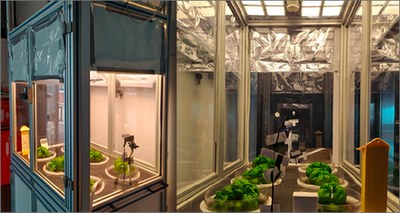Innovation: OLED lighting for the agriculture of the future
4/2/2021
 Fostering indoor plant growth thanks to a new generation lighting technology designed to optimize people’s comfort and save energy.
Fostering indoor plant growth thanks to a new generation lighting technology designed to optimize people’s comfort and save energy.
This is the objective of the project ISAAC (Innovative Lighting System for growing plants in Indoor Environments and improving human well-being) funded with approximately 4.8 million euro by the Ministry of Economic Development and launched at the ENEA Portici Research Center, where lighting systems based on OLEDs (Organic Light Emitting Diode) are being tested for the first time on plants.
The project brings together ENEA’s expertise in agronomy and innovative lighting technology, that of the FOS Group in information technology and telecommunications, and that of Becar S.r.l., of the Beghelli Group, in the lighting sector.
"OLEDs are electro-luminescent devices in which the emission of light is due to the recombination of electric charge transported in organic materials, that is, carbon-based molecules.
Their main characteristics are: large emission area, generation of glare-free, diffused light and high conversion efficiency, therefore low operating temperature that does not require heat sinks ", Maria Grazia Maglione, ENEA researcher at the Nanomaterials and Devices Laboratory, explained.
The experimentation conducted showed that OLED lighting with diffused light and a white spectrum with a warm tone, has positive effects on plant growth and their secondary metabolism.
The research line pursued is a continuation of the activities started with the project SMARTAGS, which yielded the ENEA-FOS patent "Microcosm", an actual hi-tech field simulator created for the first time in Italy, for indoor and extreme environments cultivation of plants like olive trees, potatoes, tomatoes, lettuce and basil, using the earth as a substrate.
"The experimentation employed 24 OLEDs of approximately 150 square centimeters each, arranged to form a bright carpet over the entire surface of the roof of the microcosm, without the need for diffusers to achieve a uniform light intensity on plants," Maglione said.
The OLEDs utilized were designed to produce light for indoor anthropogenic environments such as homes or offices and have not been modified for plant lighting.
“We did not apply any filter to modify the light and make it more suitable for plant growth, in order to verify if this type of light could be beneficial in this case too,” Maglione concluded.
OLED lights also feature characteristics which make them a most suitable solution for indoor lighting and open up new possibilities to create design lighting objects and architectural elements, not possible with other sources of light.
For more information please contact:
Maria Grazia Maglione, ENEA - Nanomaterials and Devices Laboratory, mariagrazia.maglione@enea.it
